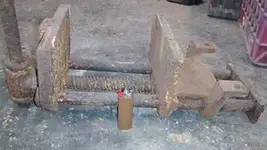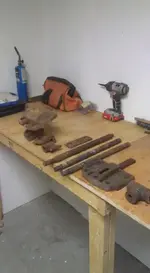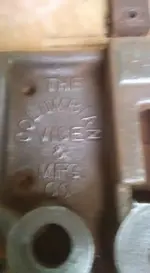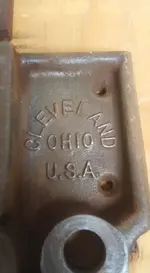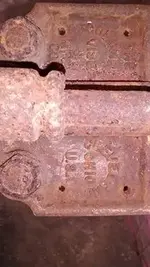So I've been reading about plating all day, looking at chemicals, anodes, pre made kits, tutorials etc... and I know a little more than I did this morning but now my brain hurts too.
If anyone has any experience with this, I'd love to be able to ask some questions and get some advice.
I have a good deal of experience when it comes to plating.
Through over 40 years of osmosis.
I am a precision machinist / toolmaker, with the specialty of precision grinding.
When it comes to restoration, rebuilding, upgrading, modifying, I can lend advise.
When is comes to successful plating the start is "prep"
Clean and brite does not always mean "clean".
So, those guide rods. Brite and clean, super clean,.....
Measure them very well.
For size, any taper, roundness, etc.
Note everything down.
You can mark them on the flat end to know which is which.
Clean up the females, the I.D.'s.
The ones on the stationary jaw will be a press fit, the movable jaw will be a slide / slip fit.
Measure carefully and note down what the findings are.
Now you develop a plan.
There is more than one kind of Nickel plating,......
I read minds, so I know that you are thinking, "Bright Nickel"
Bright Nickel doesn't require a copper base, but very often it gets one.
Copper plating is often used as a base plate because it just flies onto the piece,......
and provides a wonderfully "conductive" surface,.......
"Copper sticks to everything, and everything sticks to copper"
Copper plating also is used to fill in pits, nicks, dings, scratches, flaws, etc.
Like this example,........
* Automotive Show Chrome
*(Triple Chrome)
> Motorcycle Fender
Strip the present chrome
Polish on the "Hard Wheel" to expose pits and flaws.
Get the thing looking pretty good, note all the pits, etc.
Judgement, Judgement, Judgement,......
If you polish out the pits and flaws entirely, the piece will become too thin.
Glass bead the piece with fine grit.
Put it in the alkali cleaner, rinse in DI water, repeat.
Set it up and throw some copper plate on the piece.
Again, judgement,.....
You want to fill the pits and bring on a bit of a blend to the surface.
Bring on "uniformity"
Back to the hard wheel,.....
Evaluate, throw on more copper, and hit it on the wheel again?
Ok, moving ahead,......
You have the surface of the piece nice uniform, and you buffed it to a mirror finish.
Super clean the piece, and put it in the Nickel tank.
Throw on some nickel, take it and buff the daylights out of it.
Super clean the piece and set it up for the chrome tank, throw some chrome on.
Buff the daylights out of it.
Clean it 100%
Wrap it in that brown paper
Call the customer
Listen to him have a stroke over the phone over the cost
Customer is dead, list the fender on ebay and try to recover some money
Note 1)
The surface,...... brushed finished, belt sanded, glass beaded, buffed and polished,.....
That is what you will have after plating.
Plating is not a magic paint that makes everything look new again.
You want a bright and shiny workpiece?
The piece has to be bright and shiny when it goes into the plating tank.
Note 2)
The distance between the holes, and how parallel they are are an issue too.
As is how the distance between holes compares, ie, the stationary jaw vs. movable jaw
Note 3)
That nickel will look perfect, but later, when the vise has seen some use,
will get scratched up badly. (grit, and filings will do it's dirty work)
Consider industrial Hard Chrome, per QQC-320.
Chrome is 72 / 74 Rockwell C scale.
Even if an expert, who knows all the tricks, like baking the nickel plated piece
within 1 hour of it being removed from the tank to bring up the hardness,......
can "maybe" push the nickel to 56 / 58 Rockwell C scale.
And that honestly is what can be achieved on "Electroless Nickel", bright nickel?
Probably, I would have to check, but probably bright nickel would come up.
As plated bright nickel comes in at maybe 36 / 38 Rockwell C scale.
It's kind of sticky, and debris can become logged in it.
*You have a ton of work to do.
Let me know when you have everything brite, clean, and measured.
An no, dial calipers will not cut it.
A calibrated micrometer, and an intermic or bore gage set to known size.
(at minimum a calibrated micrometer and a precision pin set)
I hope you have a friend that is a precision machinist or toolmaker.
There can be no question about the sizes you're dealing with.
